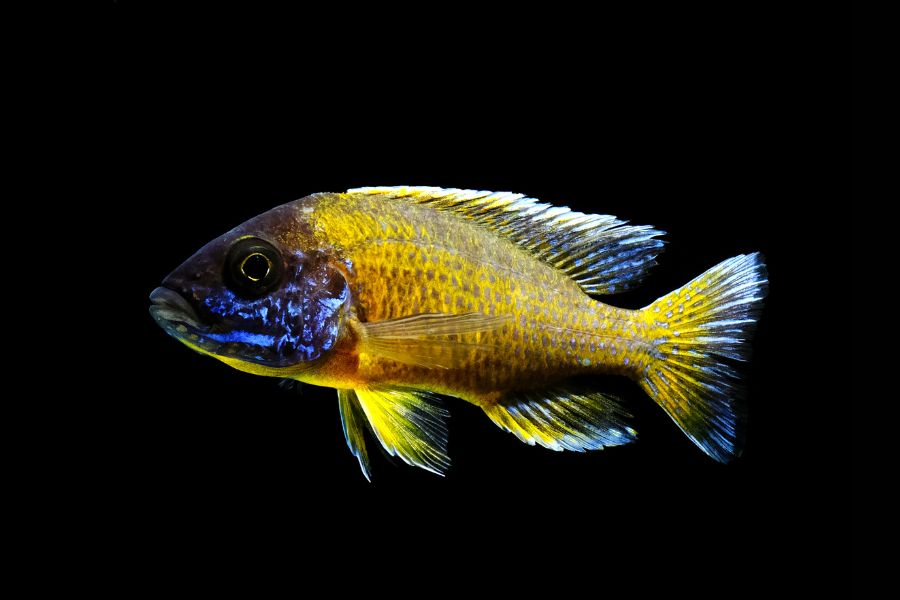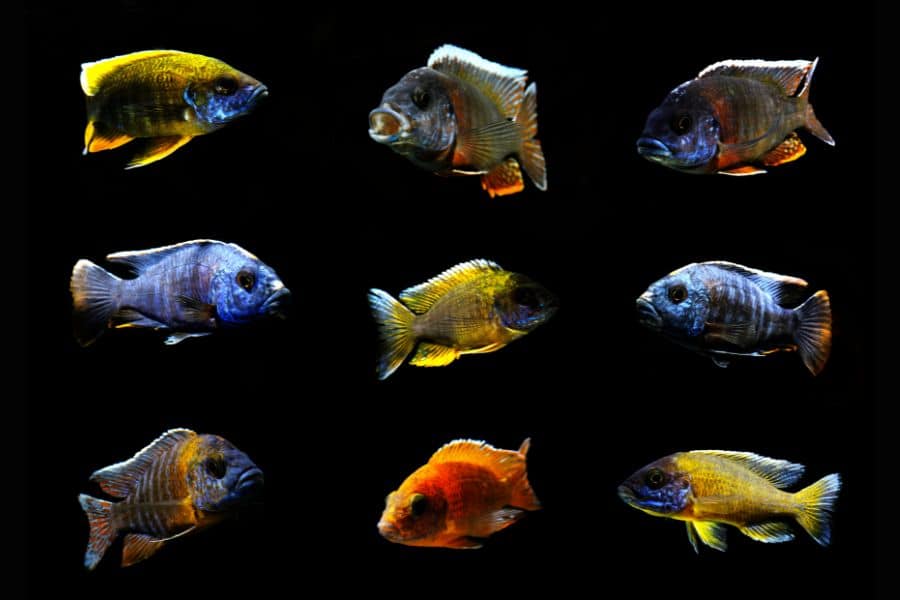African waterways including Tanzania and Tumbuka are the habitat of a huge community of species called African cichlids. Cichlid subspecies are available in a number of bright hues and are common tank animals.
The lifespan of these bright, appealing cichlids is from 6 to 10 years. It represents a normal cichlid lifetime; however, it varies from its subspecies. A cichlid’s possibility of living a long life depends on its level of maintenance and the habitat it lives in.
We’ll go into more detail on African cichlids’ lifespan and ways to extend it naturally. Continue reading to find out more!
Key Characteristics of African Cichlid
Let’s go over a couple of its main characteristics before we provide you with more precise data about how to maintain this freshwater creature.
- Scientific Name: Cichlidae
- Group: Cichlidae
- Dimensions: 4-8” (7-20 cm)
- Color: Varies on sub-species
- Maintainance Level: Moderate
- Life expectancy: 8 Years
- Personality: Aggressive
- Aquarium size: 30-Gallons
What Is the Life Expectancy of African Cichlids?
The most liked and sturdy species are cichlids which have a lifespan of 6 to 10 years. As long as they receive the best care possible and are kept with compatible aquarium companions in a healthy habitat.
The expected life expectancy varies according to the type of African cichlid. A few African cichlid species, such as the Blue Peacock Cichlid, enjoy a 10 to 12-year lifetime.
Many African cichlids have been known to live for up to 15 years. The food and nourishment your African cichlids receive will also affect how long they live. Their standard of living improves with good nutrition.
The lifespan of these adorable beings could also be influenced by genetic factors. DNA will determine a fish’s lifespan if all other factors are optimal, along with its diet.
What’s the Average Size of African Cichlids?
If properly cared for, your African cichlid may grow to be as big as 10 inches. They may reach adulthood in 4 to 5 months and are normally between four to ten inches long.
When adults either stop increasing or developing quite slowly after a certain age, let’s say twenty, young African cichlids also start maturing gradually after their fast progress during the first 4 to 5 months.
Within a short span of time, the tiniest African cichlids reach a length of 2 inches. The “Imperial cichlid,” the biggest cichlid in Europe, may reach a size of up to 30 inches and needs a minimum of 2 years to mature.
How Many Years Can African Cichlids Thrive In Captivity?
The typical lifespan of African cichlids, when kept in home tanks, is 8 years. However, it is possible if their surroundings are healthy and similar to their native home, such as freshwater bodies.
In addition to clean surroundings, they must get enough diet and maximum care to guarantee that they survive for the longest time.
You may feed them properly by providing them with the living items that they prefer. Given that certain species could be herbivores, it is best to understand your pet and nurture them properly.
The specific kind of animal they are as well as their DNA might potentially influence how prolonged their lives could be. Due to their history as aggressive species, they could be difficult to manage.
As a result, when they aren’t provided with sufficient attention, they won’t stay for a longer time.
When Do African Cichlids Mature?
The maturation period for African cichlids usually lasts some months, after that their development eventually goes down. They reach an estimated length of 5 to 8 inches throughout this period.
It might take approximately 2 years for them to achieve their matured version. Although many African cichlids grow to their maximum length in a matter of months, everybody else, that is bigger due to a biological element, might take several years to do so.
Multiple aspects, including their well-being and diet, as well as the habitat inside which they thrive, may influence how much time these species would take to develop.
How to Increase Your Cichlid’s Life Expectancy?
1. Diet
The most crucial aspect in determining how long any aquatic animal will survive is its current health condition. Proper nutrition is an important part of the various measures that might contribute to this health condition.
The same could be said for African cichlids; good nutrition would help them live longer lives. They must be fed a wholesome, well-balanced meal that is mostly comprised of carnivorous proteins.
You must provide them with the highest quality food from 3 to 4 times daily in order to receive the right amount of nutrients.
2. Tank Conditions
One more suggestion for prolonging the lifespan of your pet is to maintain the aquarium’s setting safe by scrubbing it periodically and maintaining an optimum temperature.
Guarantee that the aquarium is set up to match their natural environment of freshwater lakes. You’ll also require a solid filtering system to keep the freshwater clean.
Due to the extreme level of activity in these species, maintain your aquarium on a stable platform.
3. Fish Size
Don’t forget that the length and quantity of species in your tank might affect how fast your pet matures. The tank must be a relaxing environment for your fish.
4. Substrate and Plants
A good option is to add extra pebbles that may be employed as hideout locations to defend oneself.
You may complement the pebbles in your tank with green shrubs to achieve similar results and provide it with a brighter appearance.
5. Signs of Illness
Your pet may only live for a limited time if it develops an illness, just like weak or infected people die of old age.
If they display any visible signs, they should be evaluated and treated as quickly as possible. Your fish will have a better and healthier life as a result of decreasing the likelihood of any unfortunate events.
Different African Cichlid Species and Their Lifespan
Popular cichlid species and their life expectancy:
1. Mubuna Cichlid
The mubuna cichlid may last for 8–10 years in captivity with good care and hygienic living conditions.
2. African Butterfly Peacock Cichlid
These species have groups of the biggest peacocks. They may reach their matured lengths from 4 and 6 inches to 8 and 9 inches. This species could thrive for eight to ten years if given professional care.
3. Convict Julie Cichlid
The male cichlid is roughly 4 inches shorter than the females, who are typically around 6-inch long. If provided with the necessary attention, they may survive for a minimum of ten years, and many have even been known to survive for up to 19 years.
4. Cichlid Oscar Fish
If given the right nutrition, cichlid may survive as long as 15 years in captivity, while they often only last for 8 to 12 years. Cichlid fish have an average lifespan of 18 years within their native home.
5. Texas Cichlid
In ideal tank settings, this species (Cichlasoma cyanoguttatum), a part of the popular cichlidae genus, may survive for 13 years. They have a remarkable life expectancy and could grow around 12 inches in size, making them extremely big.
6. Blood Red Parrot Cichlid
The eye-catching cichlid is a crossbreed of two cichlids that are not found naturally as it is artificially created. Usually, male cichlids are very infertile. They could thrive for fifteen years or above in captivity. They are also quite peaceful.
7. Firemouth Cichlid
When offered the right attention, the expected life expectancy of a Firemouth Cichlid is about 10 years. Experts have got many reports of this species surviving 15 years in home tanks.
8. Electric Yellow Cichlid

They may survive a maximum of ten years if suitable surroundings are there. They often only grow to a length of 3 inches and stay small until they pass away.
You should try to keep an eye on them because they are tiny, and their hostility might not alarm some people, but it might.
9. Jack Dempsey Cichlid
They have an average 15-inch growth rate and need a minimum 8-gallon aquarium. They may survive for 10-15 years, so think about that fact before you wish to take them home.
Other species:
| Name | Average Size | Life Expectancy |
| Rainbow Cichlid | 3 inches | 9 years |
| Blue Neon Cichlid | 4 inches | 5 to 8 years |
| Lemon Cichlid | 4 inches | 8 years |
| Blue Daktari | 4 inches | 8 years |
| Daffodil Cichlid | 4 inches | 8 to 10 years |
| Red Zebra | 5 inches | 10 to 12 years |
| Lionhead Cichlid | 5 inches | 5 years |
| Buffalo Head Cichlid | 5 inches | 10 years |
| Red Empress Cichlid | 6 inches | 5 years |
| Kenyi Cichlid | 6 inches | 10 years |
| African Peacock Cichlid | 6 inches | 6 to 8 years |
| White Pearly Calvus | 6 inches | 10 years |
| Angelfish | 6 inches | 10 years |
| Electric Blue Hap | 6.5 inches | 7 years |
| African Peacock Cichlid | 8 inches | 8 to 10 years |
| Blood Parrot | 10 inches | 10 to 15 years |
| Blue Dolphin Cichlid | 10 inches | 10 years |
| Star Sapphire Cichlid | 10 inches | 8 years |
| Convict Julie | 11 inches | 10 years |
| Emperor Cichlid | 30-36 inches | 4 to 5 years |
Also Read:
- How Long Do Mollies Live?
- Humane Ways to Euthanize a Fish
- African Cichlid Tank Size & Setup Guide
- Best Cichlid Tank Mates
- Severum Cichlid: Types, Care, Tank Mates
- How Long Do Betta Fish Live?
FAQs
How Many Days Can Cichlids Survive Without Food?
Cichlids may easily live for 7–10 days without eating anything if they are in good shape. Some fishkeepers believe that they can stay for 2 weeks without any food. Young cichlids will survive for around two days without nourishment.
How Many Days Can Cichlids Survive Without an Air Pump?
They could last a few weeks provided the water is perfectly motionless before their condition starts to get worse.
But, you might not even need an air compressor if your aquarium is full of vegetation or even if your filtration system generates a lot of flow.
How Many Days Can Cichlids Survive Without A Heater?
Cichlids could barely survive for roughly two days in the absence of a heater. All tropical species require warm temperatures to survive.
They may lose metabolic energy more slowly, feel lethargic, and finally get sick or have another disease if the water temperature is too low.
Conclusion
A huge species known as African Cichlids dominate the aquatic pet market worldwide. They are the perfect companion for your house because of their endearing behavior and striking coloration.
When choosing their tank buddies, keep in mind that the majority of the animals in their category have a semi-aggressive temperament. These species also have the bonus of being exceptionally simple to reproduce, which every fishkeeper would love.
In order to increase your cichlid’s longevity, it is important to provide the proper nutrition, maintain the optimal environment, and reduce stress.

